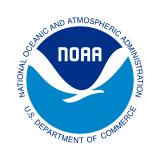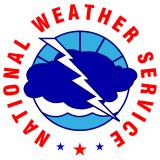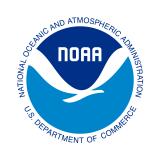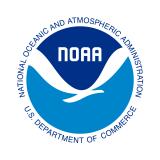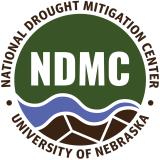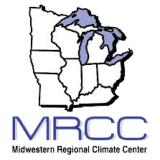For the latest forecasts and critical weather information, visit weather.gov.
Drought Improves, But Remains, Across 40% of the Midwest
Key Points
- According to the U.S. Drought Monitor, 40% of the Midwest region is in Moderate to Severe Drought (D1-D2), which is 9% less than this time last year. Areas in Severe Drought (D2) include southeast Ohio, northern Indiana, the northern half of Lower Michigan, northern Minnesota, and far northwest Iowa.
- Near- to above-normal rainfall improved drought conditions across many areas in the Midwest over the past two months, including portions of Ohio, which was in Exceptional Drought (D4) as recently as November 19. Other areas with improvement include Wisconsin, Minnesota, the Upper Peninsula of Michigan, Missouri, Illinois, southern Indiana, and Iowa.
- Below-normal precipitation led to worsening drought conditions in some areas over the past two months, including portions of Lower Michigan, northern Indiana, southern Kentucky and southern Illinois.
- Drought impacts are typically less pronounced during the winter, but some longer-term hydrology issues remain, including below-normal soil moisture and streamflow, particularly across portions of Ohio, Michigan, Indiana, and Illinois. Dry wells and low springs continue to be an issue in southeast Ohio, and low farm ponds are a problem in northwest Ohio.
- River levels on the middle Mississippi River remain below normal and are being monitored, particularly the portion of the river between Missouri and Illinois. This portion of the river sees its lowest stages this time of year because supplemental flows from the Missouri River decline and reduced flows due to ice become a threat. When the river upstream freezes quickly due to a quick drop in temperature, river flows may drop quickly as a result. This type of event can threaten navigation, especially when the river level is already low, as it is currently.
- Short-term outlooks (8-14 day) show above-normal temperatures and precipitation are likely from December 26, 2024–January 1, 2025 for the entire Midwest region.
- Due to the possibility for above-normal precipitation in January through March across much of the Great Lakes Basin, drought is likely to be removed or at least improved in Michigan, Ohio, Indiana, and Illinois through March 31, 2025.
- With equal chances for above-, near-, or below-normal precipitation in January through March, drought is likely to persist across portions of Minnesota, Wisconsin, Iowa, and western Missouri through March 31, 2025. Wintertime precipitation is typically low; therefore, removing drought deficits in the winter can be difficult.
This update is based on data available as of Thursday, December 19, 2024 at 9:00 a.m. CT. We acknowledge that conditions are evolving.
The U.S. Drought Monitor depicts the location and intensity of drought across the country. The map uses 5 classifications: Abnormally Dry (D0), showing areas that may be going into or are coming out of drought, and four levels of drought (D1–D4).
The U.S. Drought Monitor is a joint effort of the National Oceanic and Atmospheric Administration, U.S. Department of Agriculture, and National Drought Mitigation Center.
A drought index combines multiple drought indicators (e.g., precipitation, temperature, soil moisture) to depict drought conditions. For some products, like the U.S. Drought Monitor, authors combine their analysis of drought indicators with input from local observers. Other drought indices, like the Standardized Precipitation Index (SPI), use an objective calculation to describe the severity, location, timing, and/or duration of drought.
Learn MorePeriods of drought can lead to inadequate water supply, threatening the health, safety, and welfare of communities. Streamflow, groundwater, reservoir, and snowpack data are key to monitoring and forecasting water supply.
Learn MoreDrought can reduce the water availability and water quality necessary for productive farms, ranches, and grazing lands, resulting in significant negative direct and indirect economic impacts to the agricultural sector. Monitoring agricultural drought typically focuses on examining levels of precipitation, evaporative demand, soil moisture, and surface/groundwater quantity and quality.
Learn MoreU.S. Drought Monitor Categories
D0 - Abnormally Dry
Abnormally Dry (D0) indicates a region that is going into or coming out of drought. View typical impacts by state.
D1 - Moderate Drought
Moderate Drought (D1) is the first of four drought categories (D1–D4), according to the U.S. Drought Monitor. View typical impacts by state.
D2 - Severe Drought
Severe Drought (D2) is the second of four drought categories (D1–D4), according to the U.S. Drought Monitor. View typical impacts by state.
D3 - Extreme Drought
Extreme Drought (D3) is the third of four drought categories (D1–D4), according to the U.S. Drought Monitor. View typical impacts by state.
D4 - Exceptional Drought
Exceptional Drought (D4) is the most intense drought category, according to the U.S. Drought Monitor. View typical impacts by state.
Total Area in Drought (D1–D4)
Percent area of the Midwest that is currently in drought (D1–D4), according to the U.S. Drought Monitor.
The U.S. Drought Monitor depicts the location and intensity of drought across the country. The map uses 5 classifications: Abnormally Dry (D0), showing areas that may be going into or are coming out of drought, and four levels of drought (D1–D4).
The U.S. Drought Monitor is a joint effort of the National Oceanic and Atmospheric Administration, U.S. Department of Agriculture, and National Drought Mitigation Center.
The U.S. Drought Monitor is released every Thursday morning, with data valid through the previous Tuesday at 7 a.m. ET.
A drought index combines multiple drought indicators (e.g., precipitation, temperature, soil moisture) to depict drought conditions. For some products, like the U.S. Drought Monitor, authors combine their analysis of drought indicators with input from local observers. Other drought indices, like the Standardized Precipitation Index (SPI), use an objective calculation to describe the severity, location, timing, and/or duration of drought.
Learn MorePeriods of drought can lead to inadequate water supply, threatening the health, safety, and welfare of communities. Streamflow, groundwater, reservoir, and snowpack data are key to monitoring and forecasting water supply.
Learn MoreDrought can reduce the water availability and water quality necessary for productive farms, ranches, and grazing lands, resulting in significant negative direct and indirect economic impacts to the agricultural sector. Monitoring agricultural drought typically focuses on examining levels of precipitation, evaporative demand, soil moisture, and surface/groundwater quantity and quality.
Learn More8-Week U.S. Drought Monitor Change Map (Since October 22, 2024)
Key Takeaway: Drought improved in all states in the Midwest over the last 8 weeks. The most notable improvement (3-4 categories) was southeast Ohio, the Upper Peninsula of Michigan, Wisconsin, and Missouri. Areas where drought worsened include portions of Lower Michigan, northern Indiana, southern Kentucky and southern Illinois.
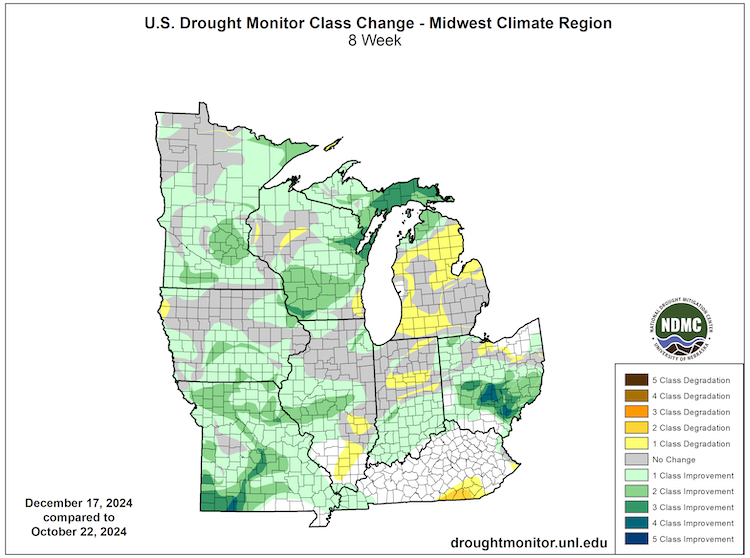
60-Day Accumulated Precipitation – Percent of Normal (October 19–December 18, 2024)
Key Takeaway: Over the last 60 days (since October 19), precipitation was above-normal (150%–300% of normal) across portions of Missouri, Iowa, Wisconsin, Minnesota, and the Upper Peninsula of Michigan, resulting in drought improvement in these areas. On the other hand, precipitation was below normal (50%–75% of normal) in Lower Michigan, northern Indiana, and portions of Illinois, Ohio, and Kentucky, and drought persisted or worsened in these areas.
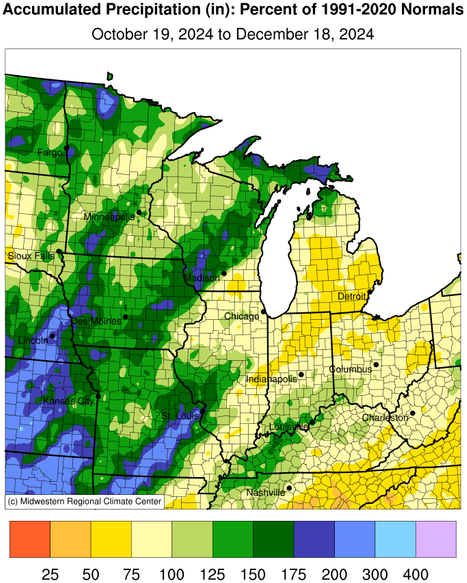
Soil Moisture Anomaly (as of December 14, 2024)
Key Takeaway: A lingering impact of drought across much of the region is below-normal soil moisture. Soil moisture is only 20%–50% of normal across areas in Ohio, Michigan, Indiana, Illinois, western Wisconsin, and northern Minnesota.
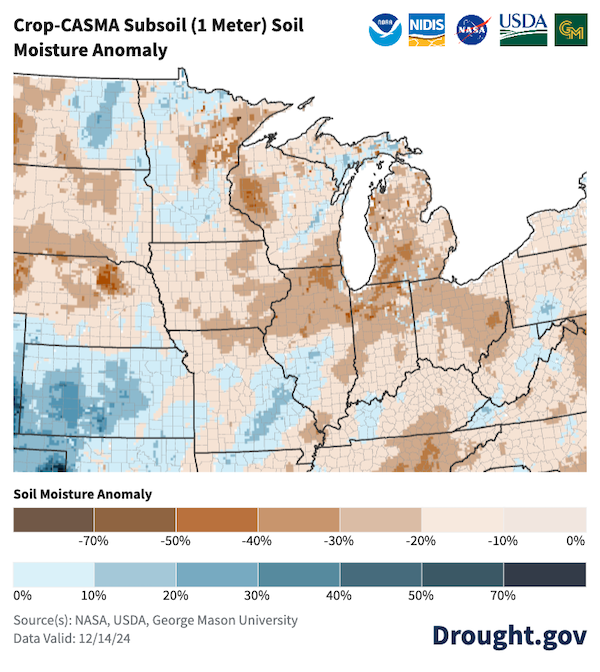
28-Day Average Streamflow Conditions (Valid December 19, 2024)
Key Takeaway: Hydrology has been slow to recover in areas that experienced drought this summer and fall, which includes Ohio, Indiana, Illinois, and Michigan.
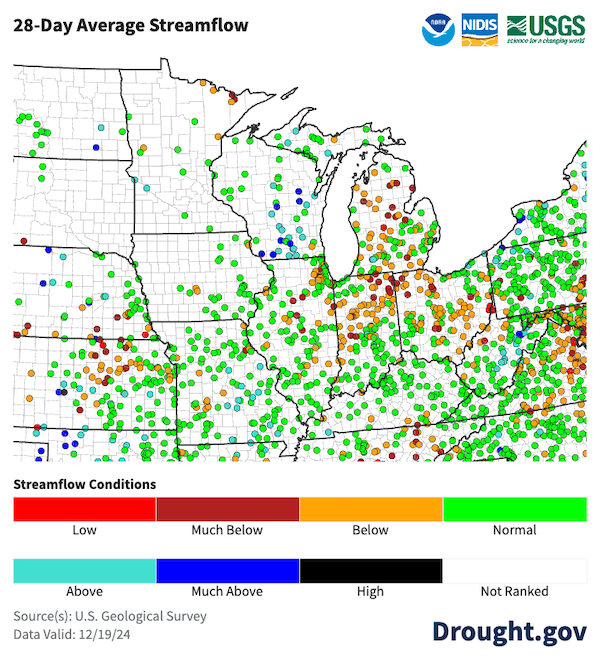
Seasonal Precipitation Outlook for January–March 2025
Key Takeaway: The precipitation outlook for January–March 2025 is a bit mixed depending on location, but above-normal precipitation is likely across much of the Midwest region, particularly over the Great Lakes basin. Other areas have equal chances for above-, near-, or below-normal precipitation.

Seasonal Drought Outlook for December 19, 2024–March 31, 2025
Key Takeaway: Due to the possibility for above-normal precipitation this winter across much of the Great Lakes Basin, drought is likely to be removed or at least improved in Michigan, Ohio, Indiana, and Illinois through March 31, 2025. Drought may persist across portions of Minnesota, Wisconsin, Iowa and western Missouri through this same time period.
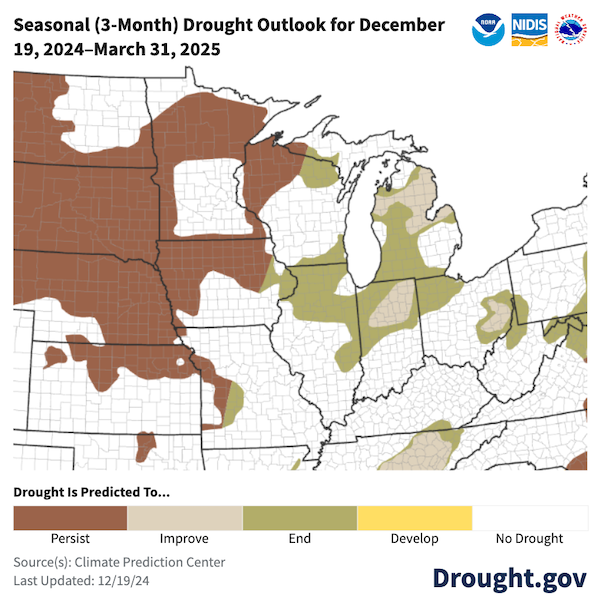
Resources
- More local information is available from the following resources:
- To report or view local drought impact information:
Prepared By
Molly Woloszyn
Cooperative Institute for Research in Environmental Sciences (CIRES), University of Colorado Boulder / NOAA National Integrated Drought Information System (NIDIS)
Doug Kluck
NOAA National Centers for Environmental Information
Dennis Todey
U.S. Department of Agriculture Midwest Climate Hub
Jeff Boyne
NOAA National Weather Service Central Region
Jim Noel & Molly Peters
NOAA National Weather Service Ohio and North Central River Forecast Centers
Anna Wolverton
U.S. Army Corps of Engineers Mississippi Valley Division / NOAA National Weather Service
Melissa Widhalm
Midwestern Regional Climate Center / Purdue University
Denise Gutzmer
National Drought Mitigation Center
A special thank you to the state climate offices and National Weather Service offices in the Midwest region for providing local information on drought conditions and impacts included in the North Central webinar and in this Drought Status Update.
This Drought Status Update is issued in partnership between the National Oceanic and Atmospheric Administration (NOAA), U.S. Department of Agriculture (USDA), U.S. Army Corps of Engineers (USACE), and the National Drought Mitigation Center to communicate a potential area of concern for drought expansion and/or development within the Midwest region based on recent conditions and the upcoming forecast. NIDIS and its partners will issue future Drought Status Updates as conditions evolve.


